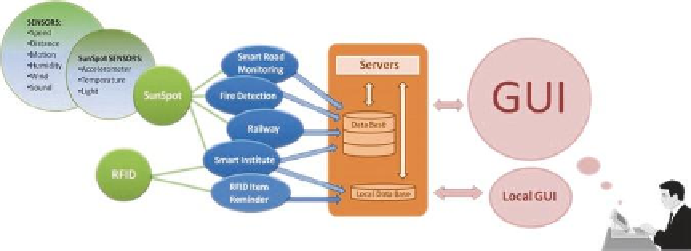Information Technology Reference
In-Depth Information
Fig. 11.1
FEEIT's testbed architecture overview
1.
Smart Institute
2.
RFID Item Reminder
3.
Smart Road Monitoring
4.
Railway Sensor Networks: Secure Transport
5.
Early Fire Detection
Two of the scenarios,
Smart Institute
and
RFID Item Reminder
, refer to the usage
of WSN and RFID for surveillance. Another two,
Smart Road Monitoring
and
Railway Sensor Networks: Secure Transport
, concern the safety issues in the traffic
communications (vehicular and railway). The last one, Early Fire Detection, targets
early detection of forest fire.
Applications for each of the selected usage scenarios are mostly performed in
Java (
RFID Item Reminder
uses C-Sharp) and stored on a server that handles repro-
gramming and data logging, while providing a web interface for online scenarios
monitoring and appropriate Graphical User Interface (GUI). The goal of the moni-
toring system is real time, interactive and remote sensors' monitoring, set up in
different environments applicable in relevant use cases. The monitoring includes
reading parameters from the sensors and their visualization. The general architecture
of the FEEIT's testbed is depicted in Fig.
11.1
.
The testbed further employs notification devices (GSM/GPRS gateway [
14
] and
alarm) for events reporting to defined authorities. The following section presents
the joint GUI and the developed application for the monitoring of the sensors'
activity.
11.2
Application for Monitoring the Sensors' Activity
The application for monitoring sensors' activity resembles the testbed architecture
overview depicted in Fig.
11.1
. The applications regarding the RFID implementation
are designed with a separate GUI and appropriate local databases.

Search WWH ::

Custom Search